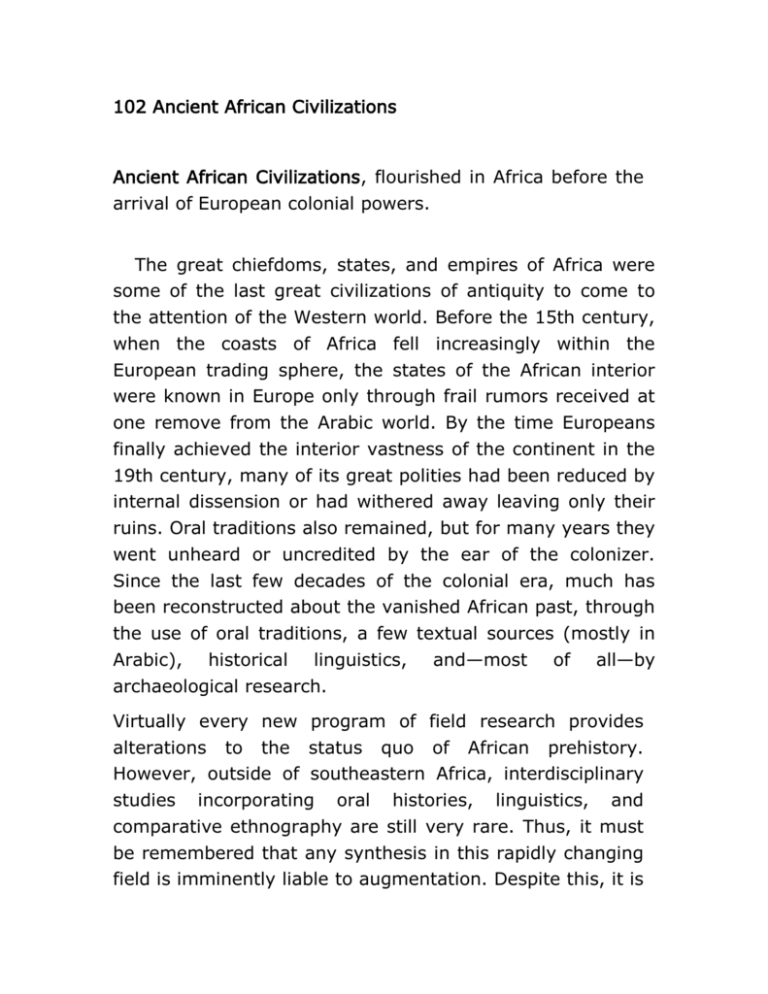
102 Ancient African Civilizations
Ancient African Civilizations, flourished in Africa before the
arrival of European colonial powers.
The great chiefdoms, states, and empires of Africa were
some of the last great civilizations of antiquity to come to
the attention of the Western world. Before the 15th century,
when the coasts of Africa fell increasingly within the
European trading sphere, the states of the African interior
were known in Europe only through frail rumors received at
one remove from the Arabic world. By the time Europeans
finally achieved the interior vastness of the continent in the
19th century, many of its great polities had been reduced by
internal dissension or had withered away leaving only their
ruins. Oral traditions also remained, but for many years they
went unheard or uncredited by the ear of the colonizer.
Since the last few decades of the colonial era, much has
been reconstructed about the vanished African past, through
the use of oral traditions, a few textual sources (mostly in
Arabic), historical linguistics, and—most of all—by
archaeological research.
Virtually every new program of field research provides
alterations to the status quo of African prehistory.
However, outside of southeastern Africa, interdisciplinary
studies incorporating oral histories, linguistics, and
comparative ethnography are still very rare. Thus, it must
be remembered that any synthesis in this rapidly changing
field is imminently liable to augmentation. Despite this, it is
possible to highlight the salient features of our current
knowledge of the first African states.
In their distribution, the ancient complex societies of Africa
cluster around the great water bodies of the continent. The
Niger and Nile river basins have both figured prominently in
the rise of African states, as have the Congo River and the
shores of the Red Sea and the Indian Ocean. It will be
observed in the earliest state formations of Saharan and
Sub-Saharan Africa that two factors played central roles:
livestock wealth and interregional trade, with the latter
eclipsing the former in importance over time. Although
much was made in first postcolonial African histories of the
role of external trade in the formation of African states,
archaeological research has indicated that extensive
internal, rather than external, trade webs formed the
principal impetus for the formation of African complex
societies.
II
AFRICA AND EGYPT
Much has been written in recent years about the
connections of Egypt and the African interior (see Egypt,
Ancient Kingdom of). Whether concerning Egypt in Africa or
Africa in Egypt, the fountainhead of this new literature was
the work of the late Cheikh Anta Diop. Embraced by the
public, and uncomfortably ignored by professional scholars,
Diop's radical tenets posited that all original early Holocene
(c. 10,000-4000 B.C.E.) inhabitants of North Africa were
black, and that they alone were responsible for the
predynastic culture of Egypt, and for all of the early
dynasties. During the Old Kingdom it was thought that
small-scale Caucasoid incursions from the Levant lightened
the skin tone of the original Egyptians, with subsequent
"invasions" from Persia, Greece, and Rome further
transforming the physical characteristics of the Egyptians.
Needless to say, this in-mixing of foreigners was thought to
be linked to the decline of Egypt, with the best of Egyptian
ideas being responsible for the grandeur of Greece and
subsequent European civilization. This is not the place to
enter into a point-by-point debate on Diop's claims, and
those of his numerous intellectual descendants. At their
best they do much to redress the anti-African bias inherent
in early Egyptology; at their worst they recreate in reverse
the oblique racism inherent in the hyperdiffusionistic school
of Grafton Elliot-Smith in the 1930s. Modern consensus
sees Egypt, from its beginnings, as a multiracial civilization,
with African cultural aspects particularly coming from
Egypt's Nubian corridor to Africa.
The great civilization of Egypt developed between
Mediterranean and African spheres of influence out of a
long tradition of incipient stratified social systems, already
boasting
well-organized
agro-pastoral
economies,
ceremonial architecture, and sailing craft (the predynastic,
5500-3100 B.C.E). Between 3100 and 331 B.C.E, Egyptian
dynasties would profoundly influence socioeconomic
developments in northeast Africa and southwest Asia, and
forever alter the landscape of Egypt with some of the most
impressive monuments known to humanity. Throughout
this time Egypt's neighbors in Nubia possessed their own
unique cultural institutions and political structures. These
southern polities sometimes cooperated and sometimes
contested the power of their northern neighbor.
Kerma, potentially the first Nubian state, prospered
between the third and fourth cataracts of the Nile from
roughly 2500 to 1500 B.C.E. During Kerma's earliest
development, its cultural influences were undoubtedly from
the African Sahel, manifested in round dwellings and
ceremonial structures, as well as distinctive burial practices
and circular tumuli featuring livestock sacrifices. Over time,
however, the cultural proximity of Egypt becomes
increasingly visible in linear-walled, fired mud-brick
architecture; more elaborate burial practices; and prestige
goods imported from the lower Nile (Middle to Final Kerma,
c. 2050-1500 B.C.E). Kerma's economy appears to have
been based upon external trade in ivory, diorite, and gold
to the north, with its subsistence base founded upon
pastoralism and an as yet unverified grain component.
From 1550 B.C.E onward, Egypt began a period of violent
conflict with Kerma, which culminated in the fall and
burning of Kerma sometime around 1500 B.C.E
After the collapse of Kerma, following a period of Egyptian
domination, other Nubian states would arise in the same
region. The most notable of these were Napata (c. 860-270
B.C.E) and Meroe (c. 270 B.C.E-350 c.e.). Napata formed
around a reemergent upper Nubian elite, with a heartland
situated south of Kerma, during a time of dissension in
Egypt. Its first rulers were buried in a monumental
cemetery at Kurru, with later rulers being inhumed near
Napata. With Egypt fragmented into approximately 11
competing polities in the early 1st millennium B.C.E,
Napata was able to push its influence northward, ruling
Egypt as a pharaonic dynasty from 750 to 660 B.C.E Egypt
then reunited under an indigenous dynasty, and Napata's
sphere of influence contracted to its original center.
From the declining Napatan state, Meroe arose and
endured for more than 500 years (c. 270 B.C.E-350c.e.).
Its center was the royal court at Meroe, although it was
eventually to stretch as a mercantile empire into lower
Nubia and the frontiers of Ptolemaic Egypt. William Adams,
the first great synthesist of Nubian archaeology, wrote that
both Ptolemaic Egypt and Meroe were "provincial
expressions of a world civilization." In other words, they
were both cultural outposts of Hellenistic Greece. Even the
most fervent Africanists would be hard-pressed to argue
against this sentiment. From Classic Kerma onward there is
a progressive cultural trend in Nubia of looking away from
Africa, and toward the Mediterranean world.
However, Meroe did retain some of its own gods—most
notably the lion-headed Apedemack. Meroe also developed
its own hieroglyphic-derived script, which unfortunately is
as yet untranslatable. Meroe is also famed for its massive
iron production, the first large-scale industry of its kind in
the Nile Valley. But the technology of this industry is
essentially Roman, rather than Sub-Saharan. Indeed,
although Sub-Saharan animals, both as living circus
animals or as animal products, continued to flow through
Nubia, the region had by this time become more of a cul-
de-sac and less of a corridor, seeking its luxuries and ideals
from the Greco-Roman world.
III CATTLE
AS
CAPITAL:
EARLY
SOCIETIES OF THE SAHARA AND SAHEL
COMPLEX
By the 3rd millennium B.C.E, a broad swath of cultures
economically dominated by pastoralism stretched across
the African Sahel, from modern Sudan to Mauritania. At
that time the Sahara was much moister than it is today,
being carpeted with grasslands and crisscrossed by
seasonally filled waterways and ponds. Its vast expanse
was also populated with linguistically and culturally diverse
groups that had both pastoral and hunter-gatherer ways of
life. The small stone and earthen tumuli and monuments
left in the wake of the early pastoral cultures attest to a
degree of social ranking in the former—probably based
around the accumulation of livestock and widely traded
polished stone objects (beads, arm rings, axes, etc.). The
origins of these mobile complex societies extend almost to
the beginnings of cattle-keeping in Africa, whose origins
may be as early as 7000 B.C.E in the northeastern corner
of the continent. From a relatively early date, they were
constructing small stone monuments of a communal
nature, including a circle of standing stones (built between
5000 and 4000 B.C.E, near Nabta Playa, Egypt), and small
tumuli for cattle "sacrifices" or lineage bulls (c. 5000 B.C.E,
Niger and Chad). Soon, however, monuments of a more
individualistic nature would appear across the central
Sahara. Stone tumuli, alignments, and burial complexes,
singling out the elites of these societies for special
treatment, are well documented from 4000 B.C.E until the
virtual abandonment of the gradually desiccating region
during the 1st millennium B.C.E .
In two places,
environmental and external social factors crystallized these
mobile societies into more sedentary and complex polities,
such as those known from Kerma (see the section on Africa
and Egypt) and Dhar Tichitt.
Around 1500 B.C.E, far in the west of the continent, the
first substantial masonry structures in Africa outside the
Nile Valley were being built. Along the escarpments of Dhar
Tichitt and Dhar Oualata, in modern Mauritania, a pristine
chiefdom developed in a deteriorating environment where
arable land and pasturage were at a premium. Remote
sensing has revealed a four-tier settlement hierarchy, with
the largest regional centers exceeding 90 hectares (220
acres) in area. The evolution of Tichitt-Oualata society
remains unclear, with competing hypotheses of long-term
local development, rapid evolution, or immigration from
elsewhere being obscured by thin stratigraphy at deflated
settlement sites. By the mid—2nd millennium B.C.E,
however, it is clear that pastoral peoples living in this zone
had started to become more sedentary, building dry-stone
masonry structures and cultivating millet. From this time
onward, the presence of large stone-walled corral areas
and numerous granary foundations points to the
importance of mixed farming, with definite evidence
present for domestic millet, cattle, sheep, and goats.
Inorganic wealth resided in the same objects valued by
contemporary Sahelian pastoral cultures: carnelian and
amazonite beads, polished stone bracelets, and a plethora
of ax types, from large functional varieties to miniature
tokens. Unfortunately, none of this region's many tumuli
have yet been excavated. It would appear that the collapse
of Tichitt-Oualata between 800 and 500 B.C.E was brought
about both by continually shrinking local ponds and
grasslands, as well as increasing harassment from Berber
interlopers from farther north.
IV
THE
EMPIRES
OF
GHANA
AND
MALI
During the 1st millennium B.C.E the advent of metallurgy
added further impetus to the growth of complex societies
south of the Sahara. Indeed, gold would play a key role in
international trade between West Africa and the
Mediterranean world throughout the late first and early
second millennia c.e. At a more regional level, iron and
copper figured as crucial sources for both practical and
prestige objects. Coupled with ivory and the slave trade ,
the control of metallurgical commodities supplanted mere
subsistence as the power basis of African elites from the
beginning of the 1st millennium c.e.
By the time Arab geographers began to write of West Africa
in the 8th century c.e., the empire of Ghana—described as
a "land of gold"—was already in existence. The origins of
Ghana, and even its precise extent, remain unclear. But we
do know that it was situated within the modern states of
Mauritania and Mali. It should be noted that he modern
state of Ghana was named after the empire because of
possible historical connections, even though geographically
there is no relation.
It was not until the 10th and 11th centuries C.E. that
travelers and compilers of travelers' tales began to
assemble a more complete written record of Ghana—an
empire reaching the end of its existence by that time. Most
notable among them were Ibn Hawkal, a late-10th-century
traveler; and the great geographical synthesist al-Bakri,
whose masterwork was completed in 1068 C.E. Only eight
years after this, the Almoravid Berbers completed their
invasion of Ghana and captured its current capital (Koumbi
Saleh). It would appear that this act laid waste to the
power structure of the state and marked its effective
dissolution.
In their writings, Ibn Hawkal and al-Bakri paint a picture of
a powerful and wealthy state able to "put 200,000 warriors
in the field, more than 40,000 of them being armed with
bow and arrow." The king, it was said, controlled the traffic
of all gold out of his kingdom to the north, and the flow of
salt from the Sahara to the south.
The ruins of Ghana's last capital, Kumbi Saleh, lie in
southeastern Mauritania; yet the most substantive
settlement clusters known from the 1st millennium C.E.
rest within the bounds of the middle Niger in the
neighboring Republic of Mali. Earlier scholarly thought
placed Ghana as a puppet state founded by Arab traders,
but recent research has emphasized the indigenous
development of regional trade webs by the Soninke people,
long before the Arab conquest of North Africa (c. 750 C.E.).
There is thus an unknown Ghana, the Ghana that existed
before the first written accounts. There is a tantalizing
reference in the Tarikh as-Sudan, a compilation of oral
traditions written in Timbuctu about 1650 C.E. It states
that there were 21 kings of Ghana before the beginning of
the Muslim era (622 C.E.) and 21 kings after that. If we
accept this as anything more than an exercise in
symmetry, then it would seem to place the origins of
Ghana sometime before 300 C.E.
Archaeologically, if we move the center of gravity
southward toward the inland Niger Delta, much evidence
exists to support this claim. The substantial settlements
that have been excavated along the middle Niger were all
in existence by this time. At some sites, such as Tongo
Maaré Diabal, permanent mud architecture is present from
250 C.E. Certainly the high point of middle Niger civilization
in terms of maximum settlement growth would date to the
period between 400 and 800 C.E., well before the textually
recorded Ghana. Was this the early Ghana eluded to in the
Tarikh as-Sudan? On current evidence, it would appear
likely. It is expected that future work will confirm the view
that the heart of the empire of Ghana, like that of the
Mandinka empire of Mali, lay not in its trade entrepôts in
the Sahara, but closer to the resource centers of the
middle Niger.
The inland Niger Delta's best-excavated sequence is that of
Djenné-Djeno (250 B.C.E to 1400 C.E.), a 33-hectare (82acre) mud-brick settlement mound. From its foundation,
the inhabitants of the site fished, cultivated rice and
sorghum, and had domestic livestock. Trade with adjoining
regions brought in commodities such as copper, iron, and
sandstone. By 450 C.E., local craft specialization, the
building of a monumental city wall, and a regional site
hierarchy centered on Djenné-Djeno point to an urban
status for the site. It must be stressed, however, that
Djenné-Djeno is only one of more than a dozen settlements
of comparable size now known from the middle Niger,
and—if one were to consider smaller settlement mounds—
only one of thousands. The occupation of such sites
continued through the time of Ghana's Islamic successor
states, the empire of Mali (1250-1600 C.E.) and the empire
of Songhai (1375-1600 C.E.).
With the conquest of Ghana by the Islamic Almoravid
movement, and the subsequent rapid disintegration of this
movement, there came a brief period of small feudal states
in this region of West Africa. These successor kingdoms
included those of Soso, in the north of ancient Ghana; and
Kangaba, located in the modern Mali/Guinea frontier zone.
Kangaba had developed out of a grouping of local Mandinka
chiefdoms and stateless societies, probably as a response
to slave raiding during the time of the late empire of
Ghana.
In the early 13th century, animistic Soso, under the rule of
Sumanguru Kante, began to expand. It raided the
territories of the Mandinka and blocked their way to
commerce in the north. Around 1240 C.E., Sundiata Keita,
or Mari-Diata, the young ruler of Kangaba, defeated the
army of Sumanguru, conquered the north, and gained total
control of the West African gold trade routes. With this
conquest, Keita founded the empire later known as Mali.
Mali was to become the first great Muslim empire of West
Africa, eventually controlling much of modern Senegal,
Mauritania, Guinea, and Mali. By 1312, Mali's greatest
ruler, Mansa Musa, took the throne. He ruled for 25 years,
making an elaborate pilgrimage to Mecca in 1324 C.E.,
during which the gold he lavished on Cairo was to have the
effect of ruining the local gold standard. During his reign
several monumental mosques were constructed within the
territory of modern Mali. However, Mali did not last as long
as Ghana, enduring as an empire for less than 200 years.
Its short life may have been due to the instability created
by its rapid expansion through conquest and its consequent
ethnic diversity and potential for internal dissension.
Unfortunately, archaeologically we know very little about
Mali. Excavations at its putative capital of Niani (in modern
Guinea) showed substantial occupations dating to before
and after the time of Mali, but very little during its epoch.
It is likely that Mali had many capitals, with the capital
moving with each new successor to the throne. Much
archaeology remains to be done in the Mali/Guinea border
region, both to understand better the origins of the
Sundiata's power base, and to locate the later centers of
Malian rule.
V
THE
IGBO-UKWU, IFE, AND BENIN: GRANDEUR IN
WEST
AFRICAN
FOREST
The first complex societies of the West African forest
probably took root sometime in the 1st millennium C.E.
Limited excavations have only begun to hint at the political
organization of these societies during the late 1st
millennium C.E., but their richness and artistic expertise
have been well demonstrated at the site of Igbo-Ukwu
(Nigeria), dated to about 900 C.E. From this site, a regal
burial and a storehouse of regalia have been excavated,
both holding superb brass castings made by the "lost wax"
method, and thousands of glass trade beads. The presence
of such wealth hints at a well-organized system of trade,
craft specialists, and a wealthy elite; but we know little of
settlements in the region until the emergence of the state
of Ife around 1100 C.E.
The tropical West African state of Ife does not benefit from
the weight of textual records available for its
contemporaries in the savanna and Sahel. However a good
deal of effort has been put into its archaeology, which is a
compensating factor. Initial archaeological inquiries at Ife
began as long ago as 1910, when the German
anthropologist Leo Frobenius visited a shrine at the living
holy city of Ife, and there acquired a series of naturalistic
bronze and terracotta busts for £6 and some alcohol. He
was later apprehended by the colonial authorities and the
bronzes returned, but seven terracottas found their way
into European museums. As a result there was much
speculation as to who could have created this magnificent
lifelike sculpture. Frobenius, on stylistic grounds, asserted
that ancient Ife was a lost Greek colony founded around
1300 B.C.E and abandoned by 800 B.C.E We now know
that this is not even remotely true. The ancient art of Ife
was entirely African in its origin, and dated instead to the
earlier part of the 2nd millennium C.E. The Yoruba city of
Ife is itself an object of wonder. It is surrounded by high
earthworks arranged in rings around the town, with the
outer ring being 11.6 km (7.2 mi) in circumference. The
date of these earthworks is not yet precisely known, but it
is assumed that at least some of them correspond with the
apogee of Ife as a political center.
Archaeological work at Ife and other sites in its vicinity has
been driven primarily by accidental discoveries during
building activities, as much of its ancient expanse remains
covered with habitations, businesses, and public buildings.
Excavations have generated a series of radiocarbon dates
that allow the reconstruction of a rudimentary cultural
sequence. Finds from between 500 and 950 C.E. are mainly
of poor grave pits concentrated near the center of the
town. However, for the period dating from 950 to 1300
C.E., there are rich graves, numerous ritual structures, and
a distribution of finds throughout, and even beyond, the
vast area enclosed by the earthworks. Most of the
terracotta portrait busts have been thermoluminescence
dated to c. 1200-1300 C.E. In some sculptures, personages
are depicted richly adorned in ceremonial regalia. Shrines
featuring such depictions may point to a form of divine
kingship that is known to have existed historically in the
region.
Perched at the edge of Nigeria's tropical forest, Ife is
thought to have come to prominence by the control of local
products (ivory, gold, pepper, cola nuts, and slaves) in the
external trade to Niger River civilizations. By 1300 C.E. its
walled capital was at the peak of its wealth, with many
shrines featuring elaborate potsherd pavements and
sculptures scattered throughout the city. To support this
large elite and artisanal population, Ife's subsistence base
appears to have been yams, oil-palm products, and small
livestock. Surrounding Ife there was likely to have been a
continuous hinterland of farmsteads. Around 1500 C.E., the
city of Ife declined, and the region's center of power shifted
to Benin, without any appreciable break in cultural
tradition, despite the fact that Benin City was founded by a
different ethnic group (Edo instead of Yoruba).
The rise of Benin and its eclipse of Ife (15th century C.E.)
corresponds to the beginning of contacts with the
Portuguese and a shift to coastal rather than riverine trade.
The first of the great kings of Benin was Oba Euware (1440
C.E.). He is said in oral traditions to have captured 201
towns and made them render regular tribute to him. He is
also said to have been the builder of the walls and ditches
of Benin, as well as external road networks. From the time
of Oba Euware on, there were further innovations in bronze
(or more properly brass) casting, with the advent of brass
plaques showing the exploits of kings, and with brass
pendant plaques being worn by local rulers and
functionaries as badges of rank. The walls of Benin are
even more spectacular than those of Ife, earning a spot in
the Guinness Book of World Records as the world's largest
earthwork. Benin City continued to flourish until the advent
of the colonial era, when a British punitive expedition
sacked the capital in 1897.
VI PRE-AKSUMITE AND AKSUMITE CIVILIZATION IN
ETHIOPIA
Like Meroe, which was more linked to Egypt than Africa, we
find in Aksum another outwardly looking state, wedded to
the trading sphere of the Red Sea and southern Arabia
rather than the African interior. Although there has been
some debate concerning the cultural origins of Aksum, it is
most likely that there was in fact an undifferentiated
Ethiopian/South Arabian cultural sphere from the late 1st
millennium
B.C.E
into
the
1st
millennium
C.E.
Unfortunately the epoch most likely to shed important light
on this matter, the pre-Aksumite period (500 B.C.E-100
C.E.), has barely been studied. Indeed, little has been well
documented save several religious and funerary shrines
bearing South Arabian inscriptions. The best preserved of
these are known from the site of Yeha, where there is a
pre-Aksumite temple dedicated to the South Arabian moon
god Alouqah. In addition, it can be noted that the
distribution of pre-Aksumite material culture more or less
equates to that of later Aksum: the northern
Ethiopian/Eritrean highlands. Thus, Aksum has been
viewed as the successor to this earlier complex society. The
last few centuries of the pre-Aksumite period are
sometimes referred to as the Intermediate Period. During
this time inscriptions in South Arabian script decline, being
replaced by a local script based upon the Ge'ez language.
Classic Aksumite civilization prospered between 100 and
600 C.E. The first textual mentions of Aksum may be found
in the Periplus of the Erythraean Sea, an Alexandrian Greek
trading guide published in the late 1st century C.E. The
guide makes reference to a metropolis called "Axomite."
There is also a mention in Ptolemy's Geography that would
lead us to expect a city and a king's palace at Aksum in the
mid-2nd century C.E. Archaeologically, during this early
Aksumite period, the first stellae are known to have been
installed in the funerary park of the city of Aksum. Textual
records from South Arabian temples indicate that by the
3rd century C.E., Aksumite armies were fighting with
success in southern Arabia, allied with local rulers, and
being led in person by the Aksumite king Gadarat. By 270
C.E. Aksum was minting its own coinage, marked with a
distinctive disk and crescent symbol and the head of the
ruler (in the first case, King Endybis). Between 200 and
330 C.E., Aksum's greatest monuments were erected.
These include the underground chambered tombs of Nefas
Mawcha and the Tomb of the Brick Arches, as well as the
great stellae of Aksum (the largest being 30 m, or 98 ft, in
height, and weighing 517 tons). These stellae were carved
from single blocks of stone, with low-relief sculpture on
their surfaces representing multistoried structures with
doors, windows, and beams. By this time we know that
Aksum was supplying African luxury goods (particularly
ivory and animal skins) to the Red Sea trade, receiving in
return precious metals, glass, cloth, wine, and spices.
Aksum's most celebrated king, Ezana, came to power
around 330 C.E. During his reign Aksum was sovereign
over Ethiopia as well as parts of Yemen and Sudan. Ezana
converted to Christianity in 333 C.E. There followed a trend
toward simpler burial traditions, and the replacement of the
disk and crescent with the cross on Aksumite coinage.
From C.E. 600 onward, Aksum began to decline. Aksum
ceased to be the state's capital in 619 C.E. At this time the
kingdom also lost its one seaport of Adulis, as a result of
internal dissension. One of the world's first Christian states,
Aksum's successors were to retain their religion in the
wake of the Islamic expansion of the late 1st millennium
C.E.
VII THE SWAHILI COAST AND THE EAST AFRICAN
INTERIOR Along the East African littoral, during the 1st
millennium C.E., coastal trade was to play an important
role in the elaboration of local social hierarchies, just as
trans-Saharan trade was doing in the west. Likewise, for
many years the
Swahili
civilization—a chain of
semiautonomous city-states dotting the East African
coast—was thought to be the direct result of Arabian
colonization. Its cities were viewed as the very edge of the
Islamic world—wealthy trading posts perched on the edge
of a foreboding interior from which trade goods would
"appear" in exchange for cloth and beads. However, the
past few decades of research have exposed the indigenous
African roots of the Swahili culture and their eventual
synergy with incoming Arabian/Islamic culture.
Although the guide written in the late 1st century C.E.,
Periplus of the Erythraean Sea (see the section on the
Aksumite civilization), cites the presence of a trading city
(Rhapta) along the coast of Kenya or Tanzania, little
substantial archaeological evidence exists for East African
trading societies until the 9th century. However, there is
some encouraging recent evidence from the site of Unjuja
Ukuu (situated at the southern tip of the island of Zanzibar,
Tanzania). There, local ceramics have been found in
stratigraphy with fragments of Egypto-Roman pottery, with
the whole assemblage radiocarbon dated to 400-550 C.E.
This at least attests to coastal trade with Roman Egypt by
that time, and hints that Rhapta may not be a myth.
By 800 C.E., Swahili trading cities dotted the East African
coast, fusing Islamic religion and architecture with
indigenous sociopolitical organization and commercial
acumen. Trading settlements, of which 170 are known,
eventually
extended
from
southern
Somalia
to
Mozambique. From these towns the Indian Ocean acted as
a trade corridor to the Far East, with lateen and squarerigged dhows stocking the menageries of Chinese
emperors, and carrying silks and porcelain to Swahili
merchants and their sultans. At an incipient level, it is now
apparent that Swahili civilization arose out of coastal agropastoral societies, whose gradual mastery of the sea lanes
made them ideal intermediaries with foreign mariners. At
the well-studied site of Shanga (Tanzania), mud and thatch
indigenous architecture in the 8th and 9th centuries gives
way to a local mutation of Islamic mortar and stone
buildings in the 10th century; with evidence for longdistance trade being present throughout the site's
sequence. At its apex, however, the Swahili coast packed a
lavish Islamic veneer, with impressive palaces and
mosques distributed among sites such as Kilwa and Gedi.
Indeed, by 1331 C.E., the great traveler Ibn Battutah
would write "Kilwa is one of the most beautiful and wellconstructed towns in the world." The eventual downfall of
the Swahili trading network and its days of glory was
brought about by the arrival of Portuguese mariners in the
first years of the 16th century. They sacked Kilwa in 1505
and rapidly constructed a chain of stone and wood forts
along the eastern seaboard, and the east coast trade soon
lost its efficiency. The Portuguese, unlike the Arab traders,
did not integrate well into the existing trading community.
During the time of the Swahili civilization, numerous
complex societies and states grew in the interior, often as
trade-item consolidators for the coastal trade. Farthest
from the coast were the wealthy societies of the
Democratic Republic of the Congo's Upemba Depression,
the neighboring Kisalian and Katotian polities (c. 700-1300
C.E.). Both are known for their sumptuous graves, with
those of the Kisalian suggesting wealth deriving from an
intra-African trade (copper, iron, and ivory), and those
from the Katotian suggesting firmer links with Indian ocean
commerce (cowries, conus shells, glass beads). The
successor to the Kisalian polity was the historic kingdom of
Luba.
VIII GREAT
MAPUNGUBWE)
ZIMBABWE
(AND
ITS
PREDECESSOR
Farther to the south, trading states developed where Bantu
agro-pastoralists had
already established
transient
chiefdoms based upon the manipulation of livestock wealth.
The first of these states, Mapungubwe (c. 1000-1200 C.E.),
grew up in the South Africa Limpopo River basin. Here, an
intermediary role in the coastal trade fossilized existing,
and otherwise transient, social hierarchies based upon
cattle wealth. Glass trade beads, cowries, and copper
ingots came in from the coast to the Mapungubwe hill
settlement in exchange for ivory, animal skins, and locally
mined gold. From 1075 C.E. it is apparent that artisanal
specialists existed at the site, including metal, ivory, and
bone workers, as well as spinners of cotton thread. These
items would have been of use in both local and external
trade.
A further elaboration of such hierarchies, but over a greater
zone of influence, can be seen in the state of Great
Zimbabwe (c. 1100-1450 C.E.). Famed for the towering,
dry-stone masonry architecture of its impressive central
settlement, the Great Zimbabwe tradition like Mapungubwe
consolidated the gold and animal product wealth of its
hinterland as a powerful bargaining chip in the competitive
coastal trade.
It is interesting to note that Great Zimbabwe, like Ife, was
once perceived by colonialists as an outpost of peoples
foreign to the African continent. Great Zimbabwe first
became known to Europeans through Portuguese contacts.
By 1506 C.E. there were rumors of a "King Mwene
Motapa," who ruled a series of lands ranging from the
Kalahari Desert to the Indian Ocean. However, in the 17th
century, Portuguese missionaries and historians, who by
now had seen the abandoned ruins of the interior, began to
cast doubt upon their African origins—interpreting them
instead as the remains of the vanished Christian kingdom
of Prester John, or King Solomon's mines. The first
archaeological investigations at the site in the late 19th
century set out merely to determine the nature of Great
Zimbabwe's external origins. Such work was supported by
Cecil Rhodes, who saw in Great Zimbabwe an ancient
Phoenician trading settlement, mirroring the then current
British marine hegemony. At this time, much of the site
was mined for its valuables by treasure hunters. As the
20th
century
dawned,
a
series
of
professional
archaeologists, including Keith Robinson and Gertrude
Caton-Thompson, demonstrated through excavations that
there was no evidence for a foreign presence at the site,
with local (protoShona-) pottery, art, and architectural
styles present throughout. Despite this, wrangles over the
site's origins would continue until a comparatively recent
period, with the site figuring as an important propaganda
tool in the Zimbabwean struggle for independence.
The site of Great Zimbabwe is only one of over 50 other
masonry settlements of its type scattered throughout
Zimbabwe and northern Botswana, although it is without
doubt the most grandiose. It is now known that Great
Zimbabwe was founded in the 11th century C.E. as a
relatively small-scale trading and herding center, consisting
only of Daga (mud) dwellings dotting the local hills and
valleys. But from 1085 C.E. on, profound changes began to
take place. First the labyrinthine Hill Ruin was constructed.
This high-walled multiroom structure, is accessed only by a
precipitous stone stairway winding along the side of the
hill. It has been interpreted as royal residence and a
spiritual/ritual center. Later, the Valley Ruin, with its muchphotographed
cyclopean
Elliptical
Building,
was
constructed. With its narrow, three-story-tall entrance
passageway, and central court featuring two circular stone
towers, it has been interpreted by some as a later king's
residence and by others as women's area, perhaps a
dwelling for the king's wives or a noblewomen's initiation
center. From 1085 to 1450 C.E., Daga huts continued to
dot the plains around the stone complexes, taking in
almost 100 hectares (250 acres) in area. At its height in
the 13th century, Great Zimbabwe's capital was home to as
many as 18,000 people. Subsistence to support such
population concentrations remained crucial, and it is likely
that cattle and agricultural surplus continued to play a
highly visible role in the maintenance of power.
Contemporary with Great Zimbabwe there is evidence for
regional centers subordinate to the central site. The best
documented of these is Ingombe Ilede on the Zambezi
River. There, the 15th-century graves of local rulers have
been excavated. They were adorned with necklaces of local
gold and imported glass beads, and wrapped in fine cloth
burial shrouds of which traces remain. As was the case
elsewhere in Africa, these local nodes of power served to
consolidate goods for the external trading center of Great
Zimbabwe (for example, ivory, rhinoceros horn, animal
skins, gold, and slaves). Undoubtedly Great Zimbabwe
owed much of its wealth to international trade, but it was
also part of a long-term internal development, with its
power based as much upon cattle wealth and military
power as foreign riches.
The collapse of the Great Zimbabwe occupation is dated to
the mid- to late 15th century, when most of the site was
abandoned. Reasons posited for Great Zimbabwe's collapse
have included the possible exhaustion of local gold, arable
land, or water resources, and the disruption of the Indian
Ocean trading sphere by the Portuguese. Majestic
successor states such as Khami, located farther in the
interior, soon sprang up, but none ever achieved the power
of Great Zimbabwe.
Contributed
Kevin MacDonald1
By:
Reference:
Ancient African Civilizations," Microsoft® Encarta® Africana
2000. © 1999 Microsoft Corporation. All rights reserved
1"Ancient African Civilizations," Microsoft® Encarta® Africana 2000. © 1999
Microsoft Corporation. All rights reserved.









